Performance Study of Black Shale Modified Soil for Road Use Based on Eshelby–Mori–Tanaka Theory
Abstract
1. Introduction
2. Experimental Materials and Their Physical Properties
3. Study on Cement-Soil Mix Proportions
3.1. Experimental Design
3.2. Experimental Results
3.2.1. Compaction Characteristics of Cement-Soil
3.2.2. Unconfined Compressive Strength of Cement-Soil
4. Study on Modified Soil Mix Proportions with Black Shale
4.1. Experimental Design
4.2. Analysis of Results
4.2.1. Compaction Characteristics of Black Shale Modified Soil
4.2.2. Basic Mechanical Properties of Black Shale Modified Soil
4.2.3. Analysis of the Optimal Ratio for Black Shale-Modified Soil
- (1)
- Physical and Mechanical Properties of the Optimal Modified Soil Y7S30
- (2)
- Analysis of the Failure Process of Optimal Modified Soil Y7S30
5. Strength Model of Black Shale Modified Soil
6. Conclusions
- (1)
- Cement-soil is used to improve the strength of black shale gravel. When the cement content is 10% to 30%, the optimal moisture content is 18.2~19.4%, the maximum dry density is 1.66~1.71 g/cm3, and the maximum unconfined compressive strength is 2.0~4.0 Mpa. The optimal moisture content, maximum dry density, and maximum unconfined compressive strength increase with the increase in cement content.
- (2)
- The elastic modulus of black shale modified soil is positively correlated with the cement content. Based on economic principles and highway specifications, the experimentally used black shale modified material is suitable for the subbase of medium to light secondary and below-secondary highways. The optimal mixing ratio is Mshale:Mclay:Mcement = 70:21:9. The unconfined compressive strength of the material under 7-day curing is 1.36 MPa.
- (3)
- For the optimally mixed black shale modified soil, cement hydration is nearly complete before 14 days, and the strength stabilizes around two weeks. The repeated “drying and soaking” environment is the most unfavorable for this modified soil, followed by prolonged immersion. Before entering the elastic-plastic deformation stage, the lateral deformation of the modified soil specimens is not significant. Afterward, lateral deformation develops rapidly.
- (4)
- The relationship between the strength of black shale modified soil and the content of cement, black shale gravel, and the strength of the soil can be expressed as follows: . Using this strength relationship, the impact of the mix ratio on the strength of the modified soil can be accurately predicted.
Author Contributions
Funding
Institutional Review Board Statement
Informed Consent Statement
Data Availability Statement
Conflicts of Interest
References
- Petersen, H.I. Morphology, formation and palaeo-environmental implications of naturally formed char particles in coals and carbonaceous mudstones. Fuel 1998, 77, 1177–1183. [Google Scholar] [CrossRef]
- Yu, C.; Peng, B.; Peltola, P.; Tang, X.; Xie, S. Effect of weathering on abundance and release of potentially toxic elements in soils developed on Lower Cambrian black shales, PR China. Environ. Geochem. Health 2012, 34, 375–390. [Google Scholar] [CrossRef]
- Park, S.Y.; Lee, H.S.; Kim, S.; Jeon, H.; Choi, J.; Han, Y. Correlation between adsorbed methane concentration and pore structure of organic-rich black shale from the Liard Basin, Canada. J. Nat. Gas Sci. Eng. 2021, 95, 104226. [Google Scholar] [CrossRef]
- Lin, X.; Kai, S.; Hao, Y.; Peng, Y.; Xue, F. Black shale hosted Ni-Co deposit: Research progress and prospect. Acta Petrol. Sin. 2022, 38, 3052–3066. [Google Scholar]
- Bell, F.G.; Entwisle, D.C.; Culshaw, M. A geotechnical survey of some British Coal Measures mudstones, with particular emphasis on durability. Eng. Geol. 1997, 46, 115–129. [Google Scholar] [CrossRef]
- Duan, Y.; Yang, Z.; Yu, T.; Yang, Q.; Liu, X.; Ji, W.; Jiang, H.; Zhuo, X.; Wu, T.; Qin, J. Geogenic cadmium pollution in multi-medians caused by black shales in Luzhai, Guangxi. Environ. Pollut. 2020, 260, 113905. [Google Scholar] [CrossRef]
- Charbonnier, Q.; Bouchez, J.; Gaillardet, J.; Calmels, D.; Dellinger, M. The influence of black shale weathering on riverine barium isotopes. Chem. Geol. 2022, 594, 120741. [Google Scholar] [CrossRef]
- Parviainen, A.; Loukola-Ruskeeniemi, K. Environmental impact of mineralised black shales. Earth-Sci. Rev. 2019, 192, 65–90. [Google Scholar] [CrossRef]
- Li, F.; Yu, T.; Huang, Z.; Jiang, T.; Wang, L.; Hou, Q.; Tang, Q.; Liu, J.; Yang, Z. Leaching experiments and risk assessment to explore the migration and risk of potentially toxic elements in soil from black shale. Sci. Total Environ. 2022, 844, 156922. [Google Scholar] [CrossRef]
- Sun, C.; Ling, S.; Wu, X.; Li, X.; Chen, J.; Jiang, W. Oxidation of black shale and its deterioration mechanism in the slip zone of the Xujiaping landslide in Sichuan Province, Southwestern China. CATENA 2021, 200, 105139. [Google Scholar] [CrossRef]
- Yang, Y.; Zhang, T.; Luo, J. Evaluation of slake durability for carbonaceous rocks exposed to water soaking using electrical resistivity. Constr. Build. Mater. 2023, 408, 133785. [Google Scholar] [CrossRef]
- Bryson, L.; Gomez-Gutierrez, I.; Hopkins, T. Correlations between durability and geotechnical properties of compacted shales. In Geo-Frontiers 2011: Advances in Geotechnical Engineering; American Society of Civil Engineers: Reston, VA, USA, 2011; pp. 4109–4118. [Google Scholar]
- Gomez-Gutierrez, I.; Bryson, L.; Hopkins, T. Correlations between geotechnical properties and the swell behavior of compacted shales. In Geo-Frontiers 2011: Advances in Geotechnical Engineering; American Society of Civil Engineers: Reston, VA, USA, 2011; pp. 4119–4128. [Google Scholar]
- Liu, Z.; He, Z.; Zhang, W.; Luo, S. Laboratory test and prediction model of dynamic resilient modulus of carbonaceous mudstone coarse-grained soil. Case Stud. Constr. Mater. 2023, 18, e01887. [Google Scholar] [CrossRef]
- Zeng, L.; Yu, H.; Gao, Q.; Bian, H. Mechanical behavior and microstructural mechanism of improved disintegrated carbonaceous mudstone. J. Cent. South Univ. 2020, 27, 1992–2002. [Google Scholar] [CrossRef]
- Mao, X.; Zhou, L.; Zheng, X.; Ma, B.; Liang, J. Performance Improvement of Soft Rock as Filling Material for Subgrade. Adv. Mater. Res. 2011, 250, 3444–3448. [Google Scholar] [CrossRef]
- Behnood, A. Soil and clay stabilization with calcium-and non-calcium-based additives: A state-of-the-art review of challenges, approaches and techniques. Transp. Geotech. 2018, 17, 14–32. [Google Scholar] [CrossRef]
- Sharma, L.; Sirdesai, N.; Sharma, K.; Singh, T. Experimental study to examine the independent roles of lime and cement on the stabilization of a mountain soil: A comparative study. Appl. Clay Sci. 2018, 152, 183–195. [Google Scholar] [CrossRef]
- Huang, Y.; Hu, K.; Wei, X.; Chandra, A. A generalized self-consistent mechanics method for composite materials with multiphase inclusions. J. Mech. Phys. Solids 1994, 42, 491–504. [Google Scholar] [CrossRef]
- Wu, Y.; Jia, M.; Gou, X.; Xu, W. Average Eshelby tensor of an arbitrarily shaped inclusion from convexity to non-convexity: Effective elastic properties of composites. Int. J. Solids Struct. 2023, 269, 112183. [Google Scholar] [CrossRef]
- Song, Z.; Peng, X.; Tang, S.; Fu, T. A homogenization scheme for elastoplastic composites using concept of Mori-Tanaka method and average deformation power rate density. Int. J. Plast. 2020, 128, 102652. [Google Scholar] [CrossRef]
- Office, J.E.; Cavalli, M.C.; Chen, D.; Chen, Q.; Chen, Y.; Falchetto, A.C.; Fang, M.; Gu, H.; Han, Z.; He, Z. Review of advanced road materials, structures, equipment, and detection technologies. J. Road Eng. 2023, 3, 370–468. [Google Scholar]
- Hu, M.; Xu, G.; Hu, S. Study on equivalent elastic modulus of sandy pebble soil based on Eshelby tensor and Mori-Tanaka equivalent method. Rock Soil Mech. 2013, 34, 1437–1442+1448. [Google Scholar]
- Ren, M.; Zhao, G.; Zhou, Y. Elastic stress transfer model and homogenized constitutive equation for the multi-phase geomaterials. Eng. Geol. 2022, 306, 106631. [Google Scholar] [CrossRef]
- Wang, Y.; Li, C.; Hu, Y. Experimental investigation on the fracture behaviour of black shale by acoustic emission monitoring and CT image analysis during uniaxial compression. Geophys. J. Int. 2018, 213, 660–675. [Google Scholar] [CrossRef]
- Sun, Q.; Zhang, Z.; Li, P.; Sun, Z.; Lu, D.; Gao, F. Study on bedding effect and damage constitutive model of black shale under dynamic loading. Chin. J. Rock Mech Eng. 2019, 38, 1319–1331. [Google Scholar]
- Gen, L.; Hong, F.; Wei, H. Experimental study on road performance of carbonaceous shale after pre-disintegration treatment. J. China Foreign Highw. 2012, 32, 34–37. [Google Scholar]
- JTG/T F20-2015[S]; Ministry of Transport of the People’s Republic of China: Technical Specification of Highway Pavement Base Construction. Beijing China Communications Press: Beijing, China, 2015.
- JTG 3430-2020; Ministry of Transport of the People’s Republic of China Highway Geotechnical test Code. Beijing China Communications Press: Bejing, China, 2020.
- GB/T 50145-2007; Ministry of Water Resources of the People’s Republic of China Engineering classification standard of soil. Beijing China Planning Press: Beijing, China, 2008.
- Chang, C.; Zhao, C.; Song, G. Interval Regression Analysis on Mechanical Property Index Evolution Law of Cement-soil Based on Bayesian Bootstrap Method. J. Henan Norm. Univ. 2023, 50, 227–234. [Google Scholar]
- JTG E51-2009; Ministry of Transport of the People’s Republic of China: Test Regulation of Inorganic Bond Stabilized Materials for Highway Engineering. Beijing China Communications Press: Beijing, China, 2009.
- JTG D50-2017; Ministry of Transport of the People’s Republic of China: Code for Design of Highway Asphalt Pavement. Beijing China Communications Press: Beijing, China, 2017.
- Wen, L.; Yun, H.; Shuai, H. Study on the influence of sulfate on the relationship between uniaxial compressive strength and elastic modulus of cemented backfill. China Coal. 2016, 42, 102–105. [Google Scholar]
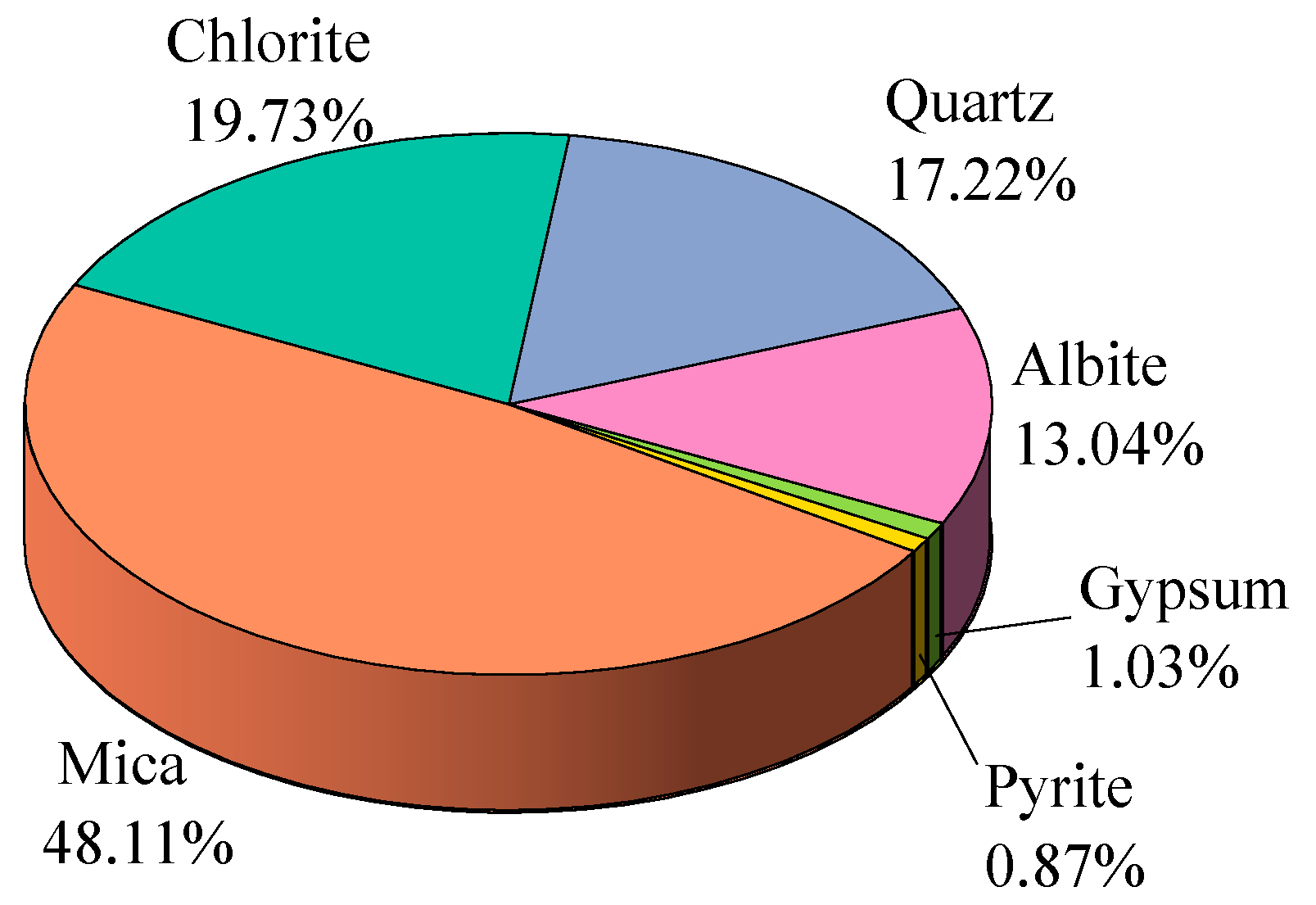


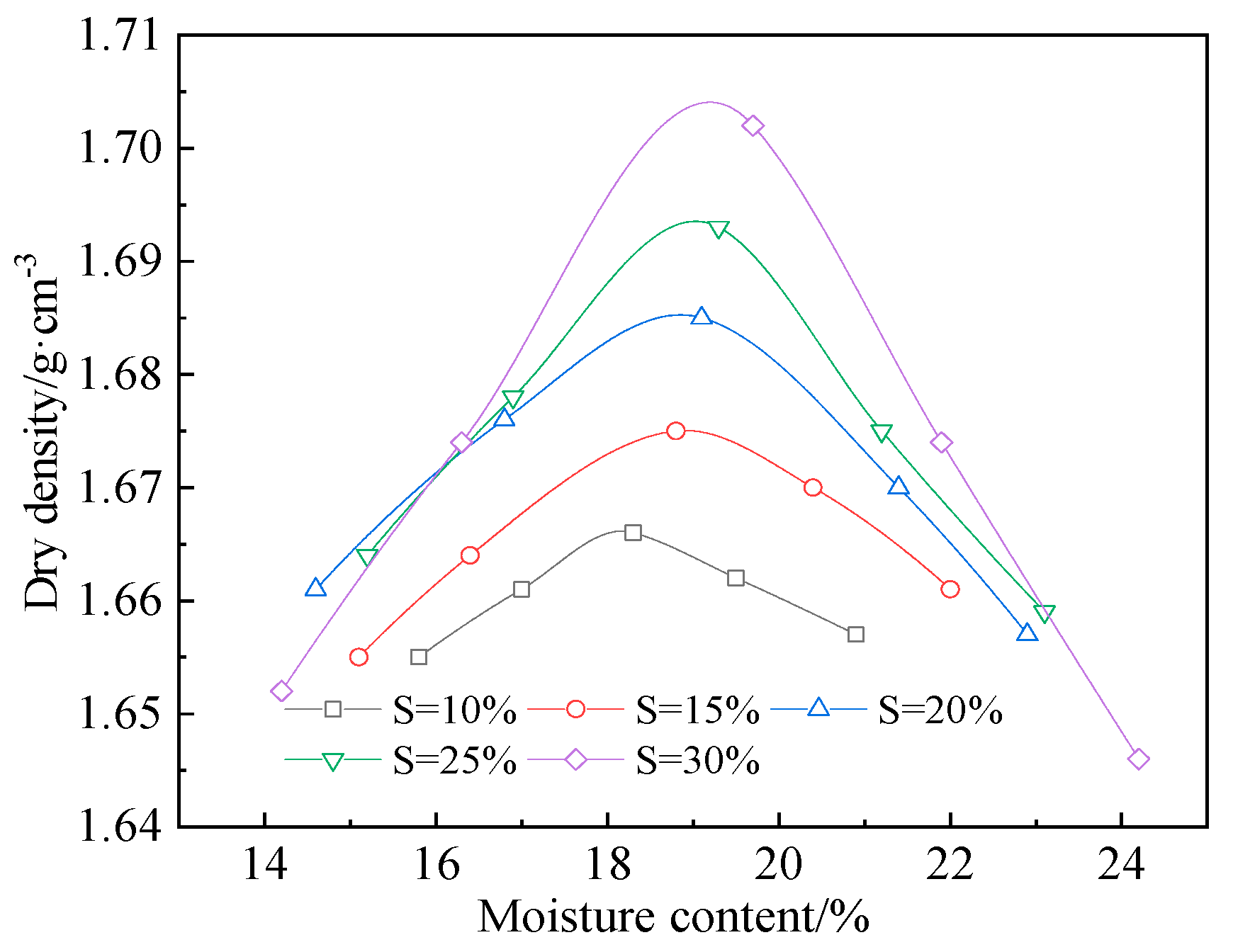
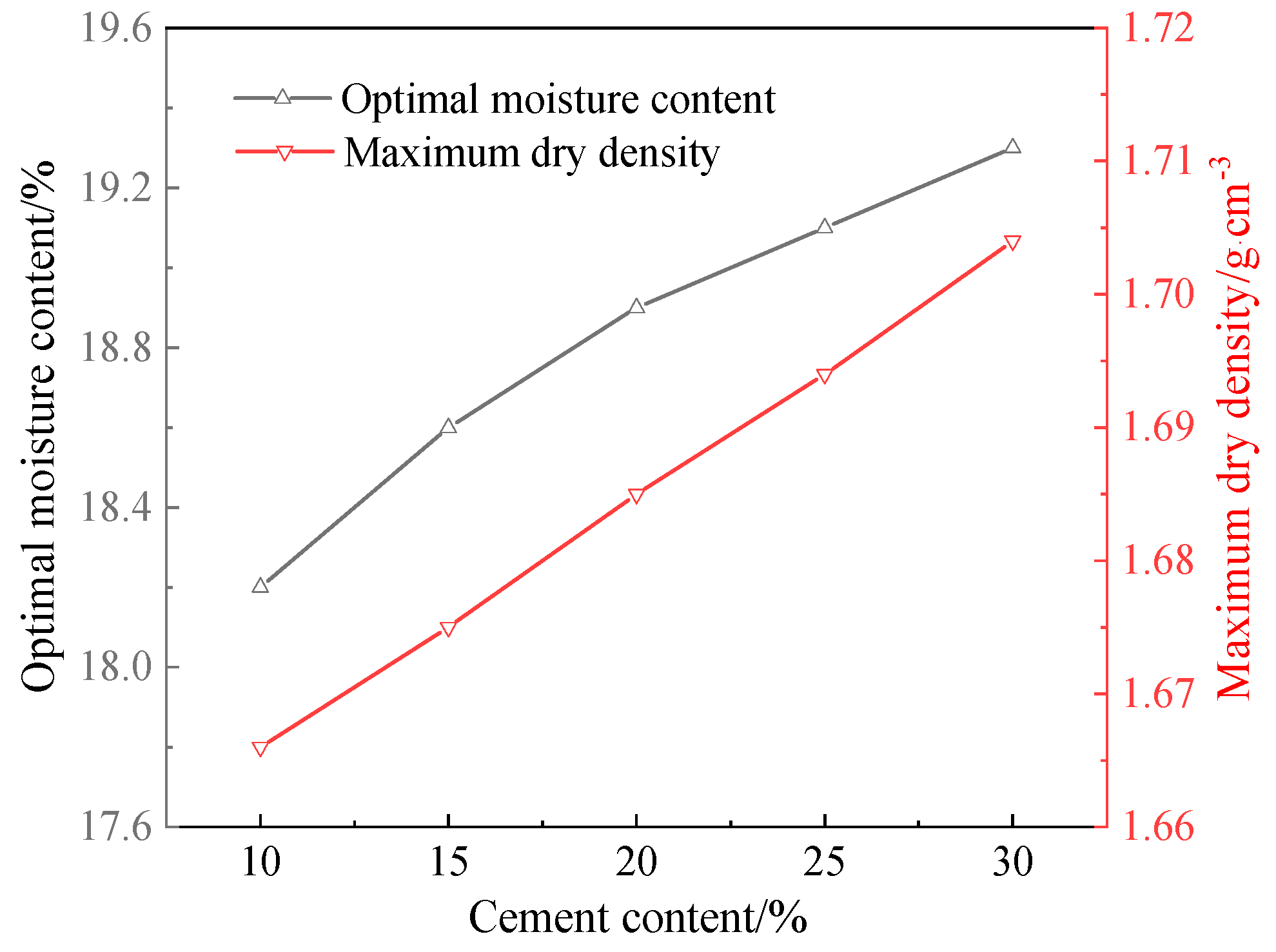
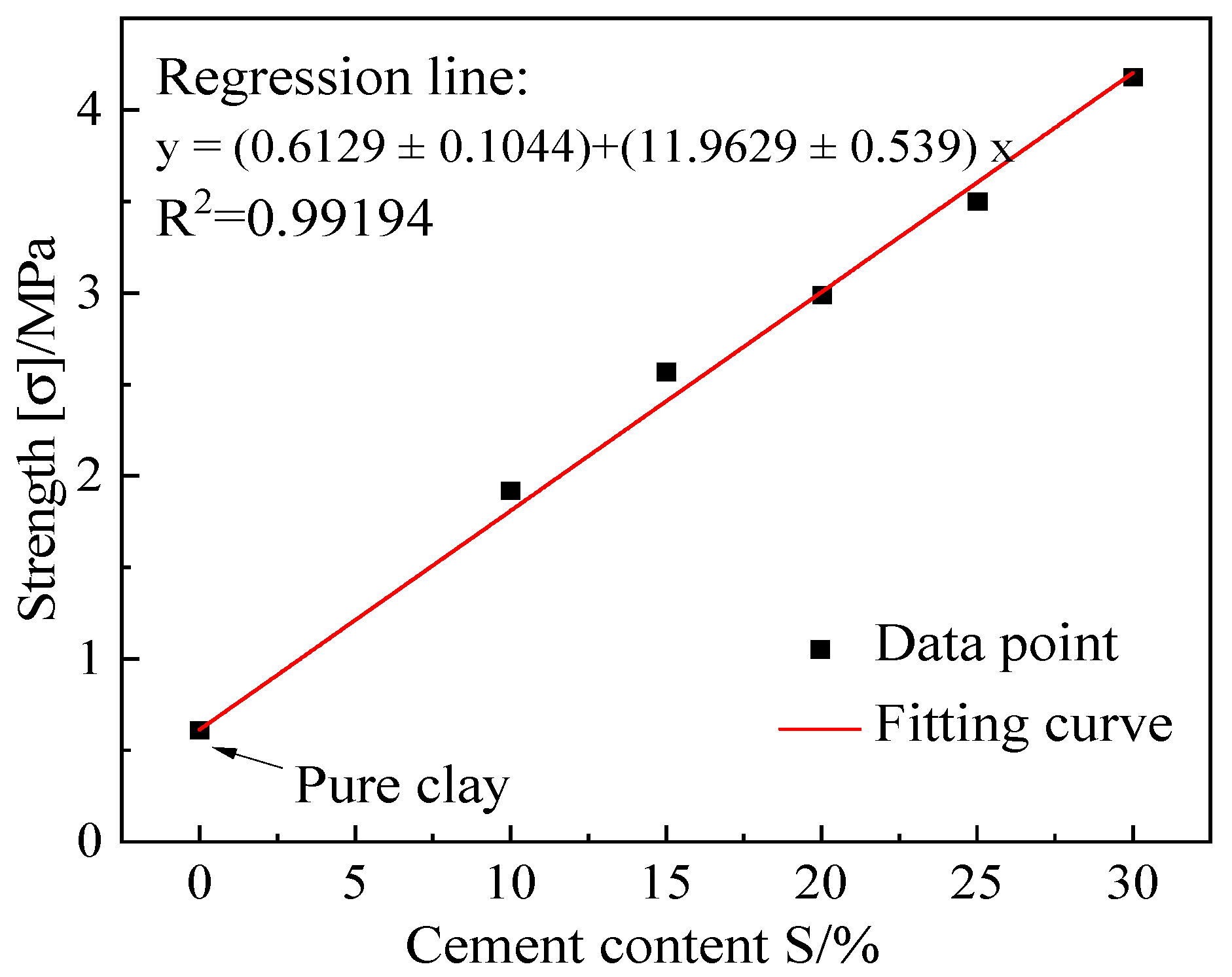

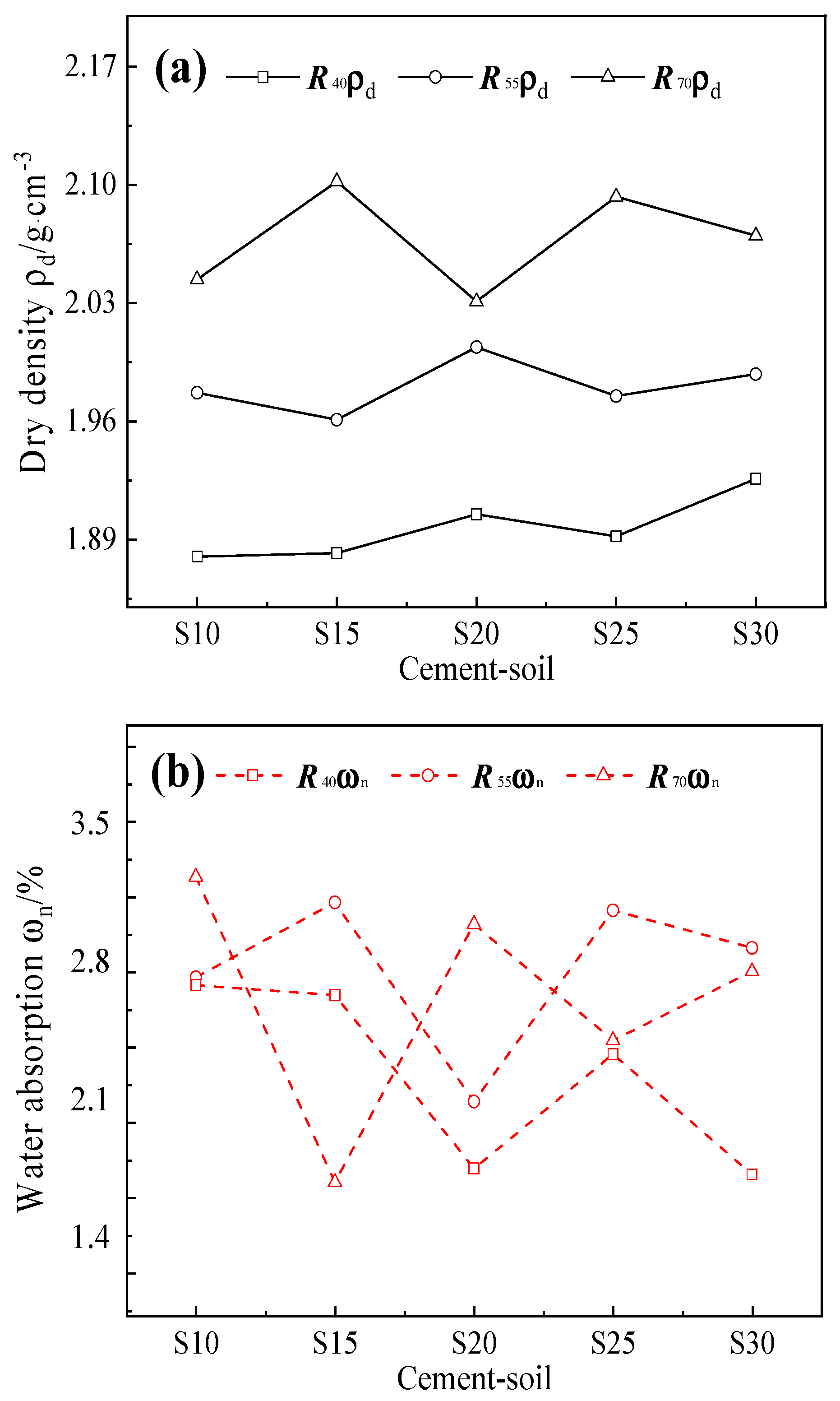
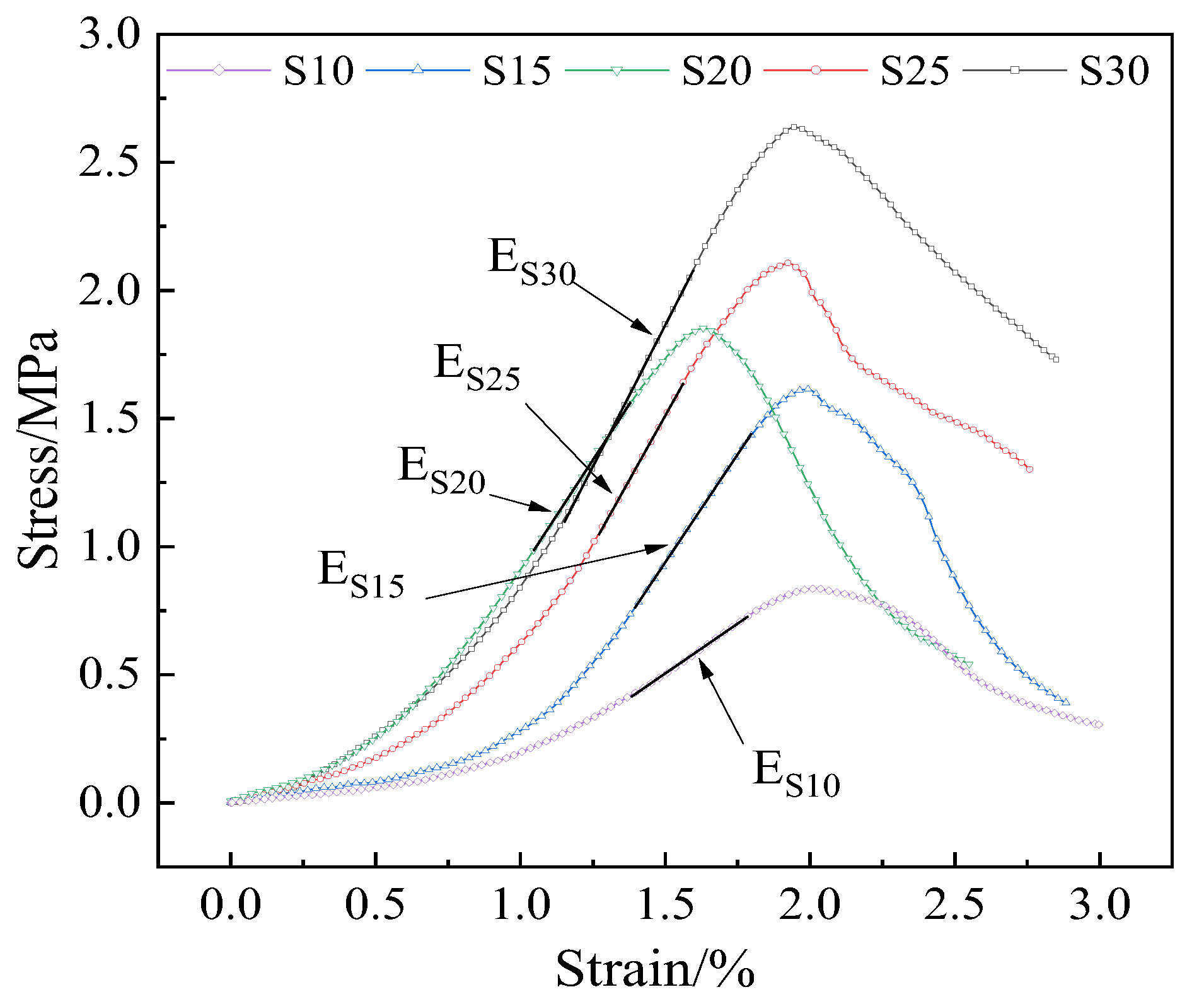
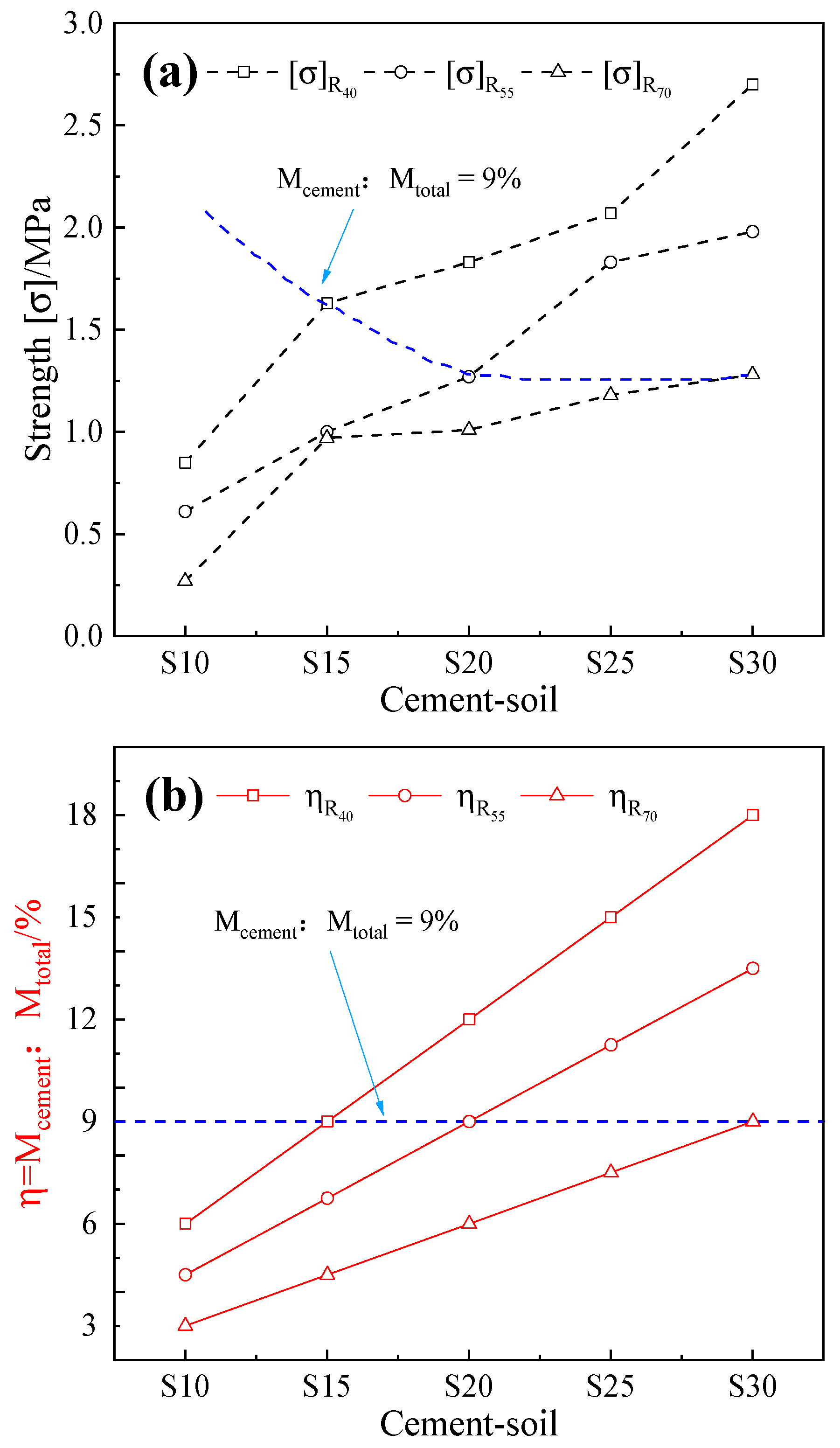

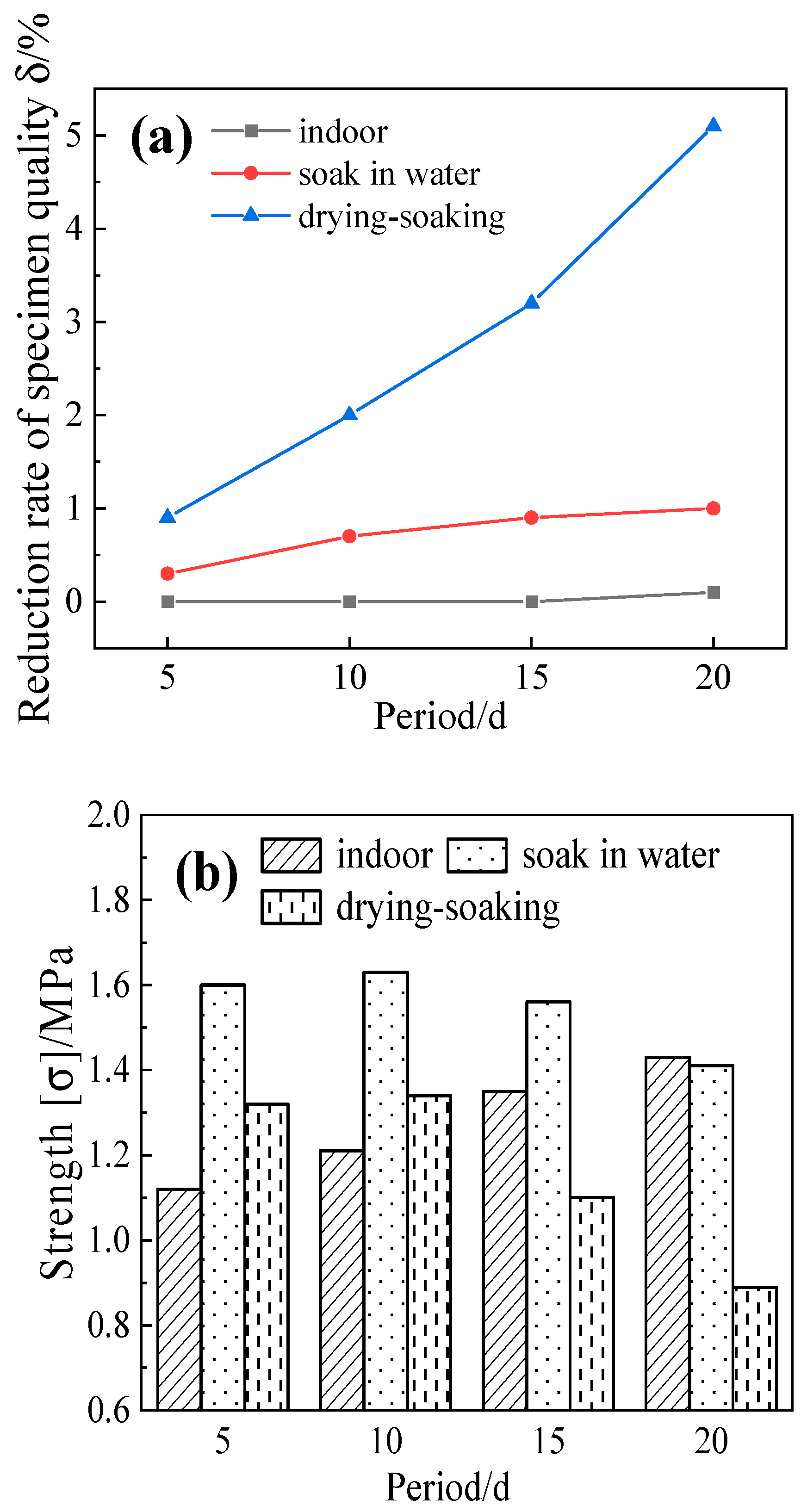
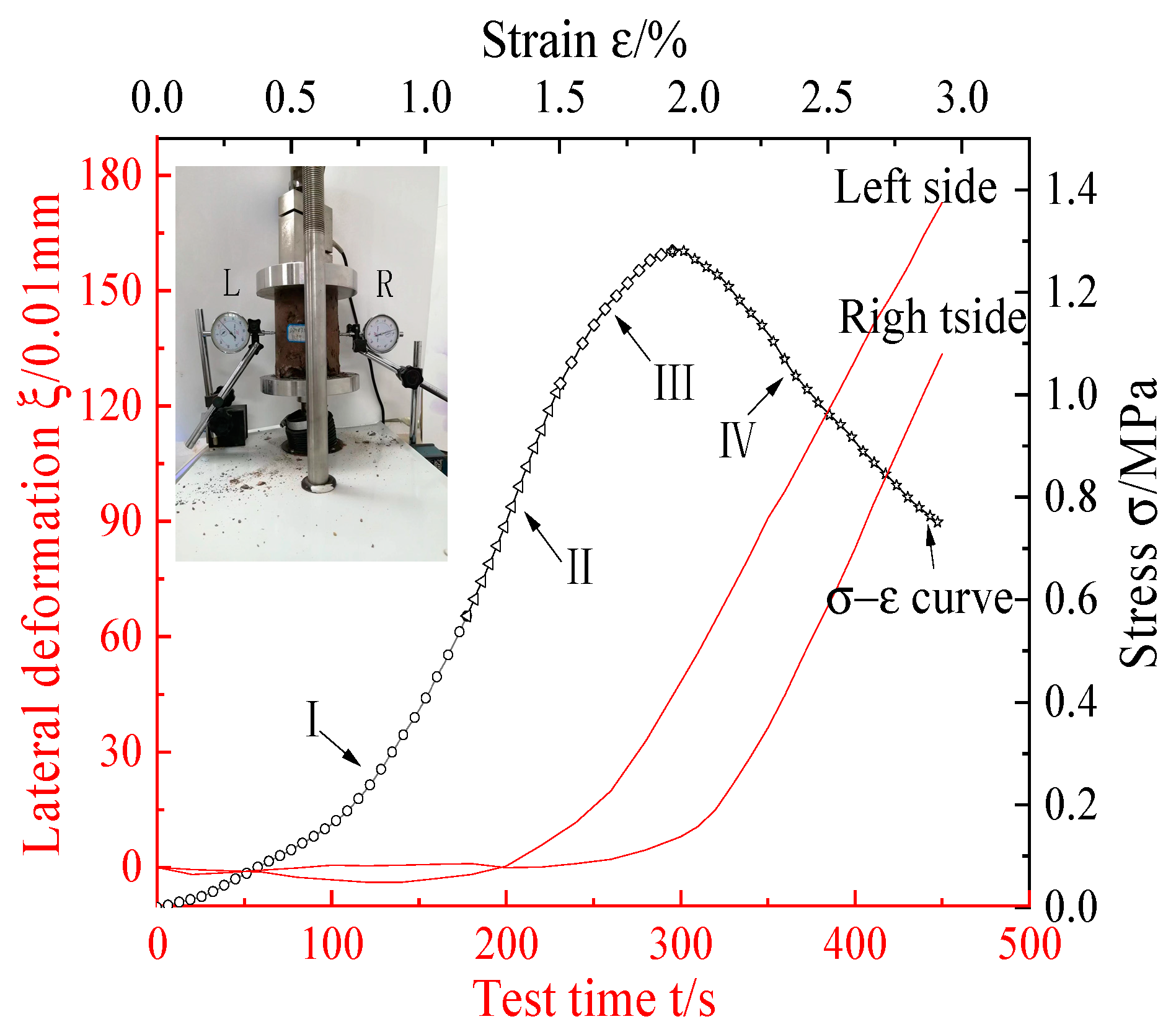


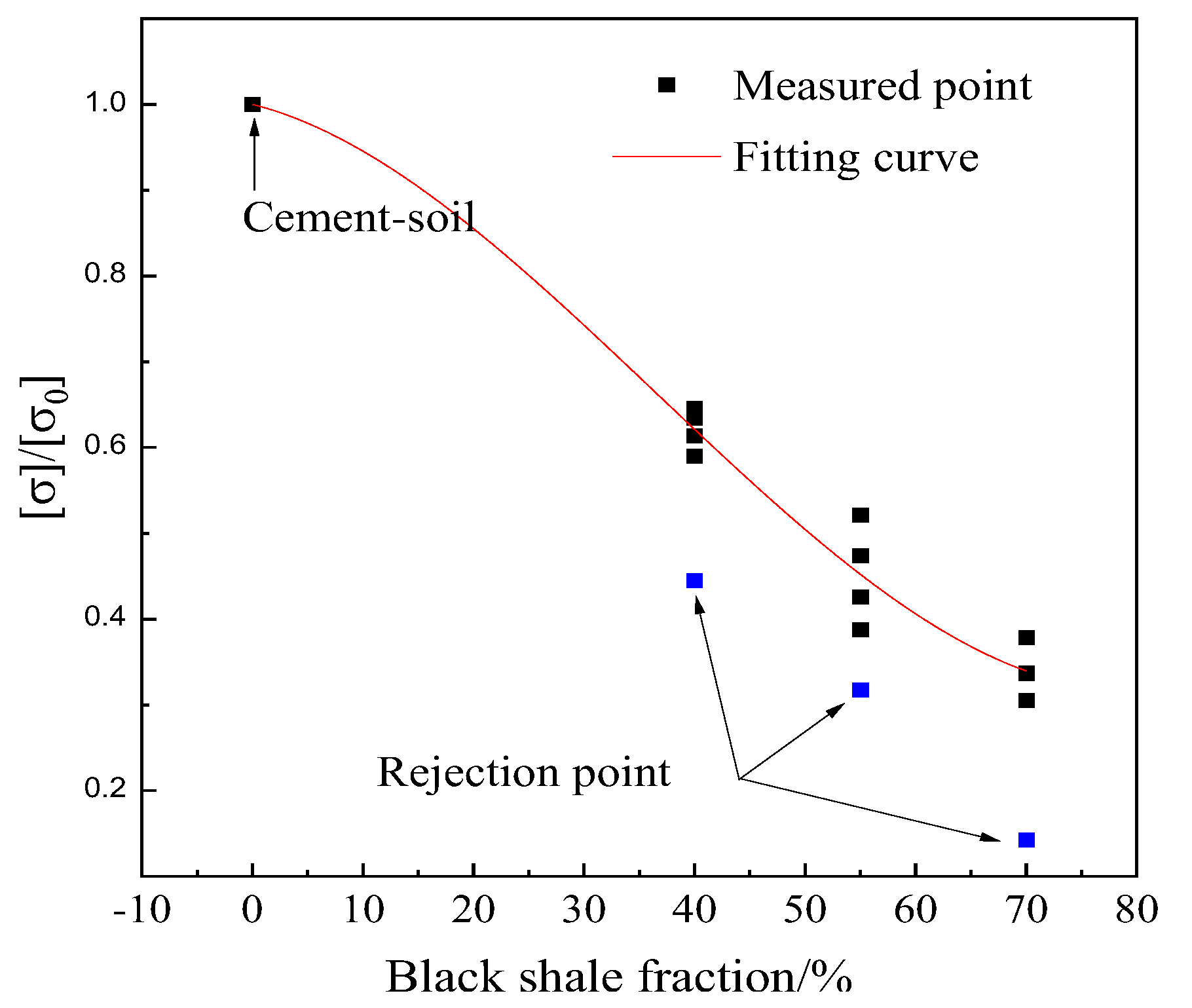

| Particle Specific Gravity GS | Liquid Limit /% | Plastic Limit /% | Plasticity Index | Maximum Dry Density /g·cm−3 | Optimal Moisture Content /% |
|---|---|---|---|---|---|
| 2.71 | 55.6 | 26.3 | 29.3 | 1.652 | 17.5 |
| Name of Composite Material | Crushed Stone Content R/% | Cement-Soil | Cement Content /% | Dry Density /g·cm−3 | Water Absorption /% | Strength [σ]/MPa |
|---|---|---|---|---|---|---|
| Y4S10 | 40 | S10 | 6.00 | 1.880 | 2.68 | 0.85 |
| Y4S15 | S15 | 9.00 | 1.882 | 2.63 | 1.63 | |
| Y4S20 | S20 | 12.0 | 1.905 | 1.75 | 1.83 | |
| Y4S25 | S25 | 15.0 | 1.892 | 2.33 | 2.07 | |
| Y4S30 | S30 | 18.0 | 1.926 | 1.72 | 2.70 | |
| Y5S10 | 55 | S10 | 4.50 | 1.977 | 2.72 | 0.61 |
| Y5S15 | S15 | 6.75 | 1.961 | 3.10 | 1.00 | |
| Y5S20 | S20 | 9.00 | 2.004 | 2.09 | 1.27 | |
| Y5S25 | S25 | 11.25 | 1.975 | 3.06 | 1.83 | |
| Y5S30 | S30 | 13.50 | 1.988 | 2.87 | 2.02 | |
| Y7S10 | 70 | S10 | 3.00 | 2.044 | 3.23 | 0.27 |
| Y7S15 | S15 | 4.50 | 2.102 | 1.68 | 0.97 | |
| Y7S20 | S20 | 6.00 | 2.031 | 2.99 | 1.01 | |
| Y7S25 | S25 | 7.50 | 2.093 | 2.40 | 1.18 | |
| Y7S30 | S30 | 9.00 | 2.070 | 2.75 | 1.28 |
| ES10 | ES15 | ES20 | ES25 | ES30 | |
|---|---|---|---|---|---|
| Elastic modulus value | 77.8 | 168.8 | 172.3 | 202.4 | 220.7 |
| Correlation coefficient r | 0.9991 | 0.9996 | 0.9998 | 0.9998 | 0.9997 |
| Material | Structure Layer | Highway Grade | Extremely Heavy, Extra Heavy Traffic | Heavy Traffic | Medium, Light Traffic |
|---|---|---|---|---|---|
| Cement stabilized class | Highway base | High grade | 5.0~7.0 | 4.0~6.0 | 3.0~5.0 |
| Low grade | 4.0~6.0 | 3.0~5.0 | 2.0~4.0 | ||
| Highway Subbase | High grade | 3.0~5.0 | 2.5~4.5 | 2.0~4.0 | |
| Low grade | 2.5~4.5 | 2.0~4.0 | 1.0~3.0 |
Disclaimer/Publisher’s Note: The statements, opinions and data contained in all publications are solely those of the individual author(s) and contributor(s) and not of MDPI and/or the editor(s). MDPI and/or the editor(s) disclaim responsibility for any injury to people or property resulting from any ideas, methods, instructions or products referred to in the content. |
© 2024 by the authors. Licensee MDPI, Basel, Switzerland. This article is an open access article distributed under the terms and conditions of the Creative Commons Attribution (CC BY) license (https://creativecommons.org/licenses/by/4.0/).
Share and Cite
Hu, M.; Huang, Z.; Chen, J.; Guo, Y.; Zhou, Y.; Liu, D.; Guo, R. Performance Study of Black Shale Modified Soil for Road Use Based on Eshelby–Mori–Tanaka Theory. Appl. Sci. 2024, 14, 1636. https://doi.org/10.3390/app14041636
Hu M, Huang Z, Chen J, Guo Y, Zhou Y, Liu D, Guo R. Performance Study of Black Shale Modified Soil for Road Use Based on Eshelby–Mori–Tanaka Theory. Applied Sciences. 2024; 14(4):1636. https://doi.org/10.3390/app14041636
Chicago/Turabian StyleHu, Min, Zhangduo Huang, Jiejin Chen, Yipeng Guo, Yichao Zhou, Dashun Liu, and Rong Guo. 2024. "Performance Study of Black Shale Modified Soil for Road Use Based on Eshelby–Mori–Tanaka Theory" Applied Sciences 14, no. 4: 1636. https://doi.org/10.3390/app14041636
APA StyleHu, M., Huang, Z., Chen, J., Guo, Y., Zhou, Y., Liu, D., & Guo, R. (2024). Performance Study of Black Shale Modified Soil for Road Use Based on Eshelby–Mori–Tanaka Theory. Applied Sciences, 14(4), 1636. https://doi.org/10.3390/app14041636





